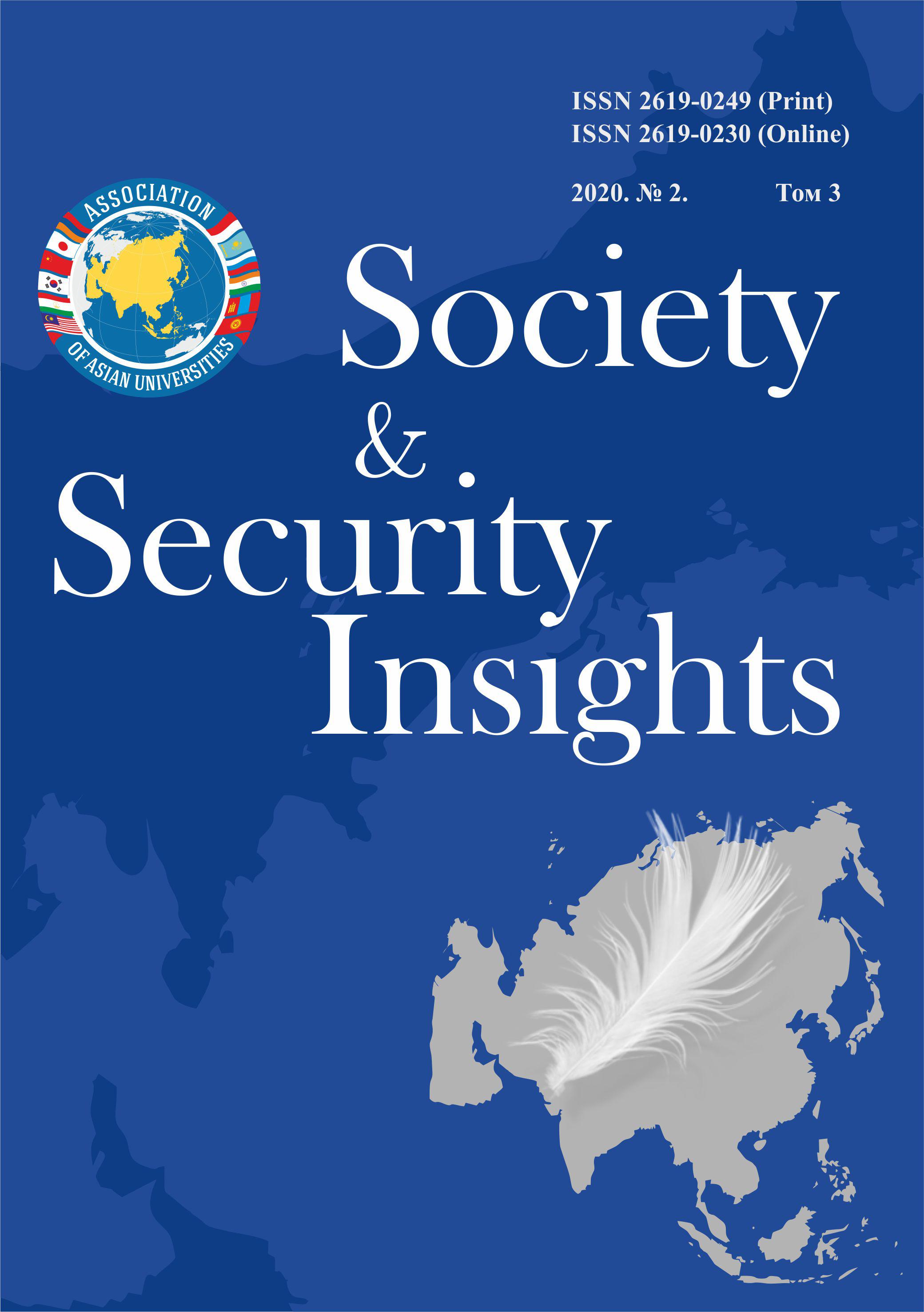СТРАТЕГИЯ ЕВРОПЕЙСКОГО СОЮЗА ПО БОРЬБЕ С ТЕРРОРИЗМОМ
Основное содержание статьи
Аннотация
В статье анализируется стратегия Европейского Союза по противодействию терроризму. Авторы дают краткий очерк формированию системы надгосударственных органов ЕС. Указывается отсутствие комплексного подхода к вопросу, недостаточность узких определений террористической угрозы. Учитывая то, что, несмотря на то, что внимание ЕС вновь (если не больше) сосредоточено на аспекте безопасности терроризма (т. е. борьбе с терроризмом), а не на мириадах других комплексных аспектов, которые ведут к нему (т. е. предупреждению терроризма), авторы статьи делают вывод, что ЕС еще не до конца понимает природу терроризма. Его политическая динамика по-прежнему обусловлена кризисными ситуациями, и ЕС, похоже, не хочет существенно отклоняться в реальном выражении от любой из своих предыдущих стратегий. На взгляд авторов, подход ЕС к борьбе с терроризмом (политика, а не риторика) останется прежним: сосредоточение внимания на сотрудничестве в области безопасности при одновременном выдвижении инициатив, создающих впечатление, что другие области, такие как гражданское сотрудничество и межкультурный диалог, не полностью исключены. Это останется главным направлением антитеррористической политики ЕС: с каждым терактом (будь то групповым или одиночным) будут усиливаться призывы к расширению сотрудничества в области безопасности в контексте интеграции ЕС и обеспечения общественной безопасности. По мнению авторов, выработка единого понятия позволит активизировать совместные действия государств по уничтожению террористической угрозы.
Скачивания
Metrics
Детали статьи

Это произведение доступно по лицензии Creative Commons «Attribution» («Атрибуция») 4.0 Всемирная.
Authors retain the copyright of their manuscripts, and all Open Access articles are distributed under the terms of the Creative Commons Attribution License, which permits unrestricted use, distribution, and reproduction in any medium, provided that the original work is properly cited.
Литература
ACPI, 2019. Mini track on the malicious use of artificial intelligence: New challenges for democratic institutions and political stability. ECIAIR 2019. European Conference on the Impact of AI and Robotics, 31 October – 1 November 2019 at EM-Normandie Business School, Oxford, UK [online]. Available at: [Accessed 31 January 2019].
Goodman, M., 2015. Future crimes: inside the digital underground and the battle for our connected world. New York: Anchor Books.
Gonçalves C.P. Cyberspace and Artificial Intelligence: The New Face of Cyber-Enhanced Hybrid Threats, 2019. URL: https://www.intechopen.com/online-first/cyberspace-andartificial-intelligence-the-new-face-of-cyber-enhanced-hybrid-threats.
Greene A. Terrorism: definition one size fits? International and comparative law quarterly, 2017, 66 (2), 411–440. doi: 10.1017 / S0020589317000070.
Horowitz M.C. et al. Artificial intelligence and international security. Washington: Center for a New American Security (CNAS), 2018.
Howell А. Madness in international relations: psychology, security, and the global governance of mental health. London: Routledge, 2011. ‘
I Never Said That!’ The High-Tech Deception of ‘Deepfake’ Videos. The Times of Israel [online], 2 July 2018. URL: https://www.timesofisrael.com/i-never-said-that-the-hightech-deception-of-deepfake-videos/. Rao A.S., Verweij G. Sizing the prize. What’s the real value of AI for your business and how can You capitalize? New York: PWC, 2018.
U. S. Army Command and General Staff College. Irregular pen and limited sword: psywar, psyop, and MISO in counterinsurgency. Colorado Springs, CO: CreateSpace Independent Publishing Platform, 2014.
U. S. Government Accountability Office (GAO). Report to Congressional Committees National Security. Long-Range Emerging Threats Facing the United States as Identified by Federal Agencies. GAO-19-204SP. Washington, DC: GAO, 2018.
Waddel K. The impending war over deepfakes. Axios, 2018, the 22nd of July. URL: https://www.axios.com/the-impending-war-over-deepfakes-b3427757-2ed7-4fbc-9edb45e461eb87ba.html
World Economic Forum. The future of job employment, skills and workforce strategy for the fourth industrial revolution. Executive summary. Geneva: World Economic Forum, 2016.
REFERENCES
Rastorguev, S.P., Litvinenko, M.V. (2014). Informacionnye operacii v seti Internet [Information operations on the Internet]. Moscow: The Centre of Strategic Assessment and Forecasts.
CPI (2019). Mini track on the malicious use of artificial intelligence: New challenges for democratic institutions and political stability. ECIAIR 2019. European Conference on the Impact of AI and Robotics, 31 October — 1 November 2019 at EM-Normandie Business School, Oxford, UK [online]. Available at: https://www.academic-conferences.org/conferences/eciair/eciair-call-for-papers/eciair-mini-tracks/.
Goodman, M. (2015). Future crimes: inside the digital underground and the battle for our connected world. New York: Anchor Books.
Gonçalves, C.P. (2019). Cyberspace and Artificial Intelligence: The New Face of Cyber-Enhanced Hybrid Threats. Available at: https://www.intechopen.com/online-first/cyberspace-and-artificial-intelligence-the-new-face-of-cyber-enhanced-hybrid-threats.
Greene, A. (2017). Terrorism: definition one size fits? International and comparative law quarterly, 66 (2), 411–440. doi: 10.1017 / S0020589317000070
Horowitz, M.C., et al. (2018). Artificial intelligence and international security. Washington: Center for a New American Security (CNAS).
Howell, А. (2011). Madness in international relations: psychology, security, and the global governance of mental health. London: Routledge.
‘I Never Said That!’ The High-Tech Deception of ‘Deepfake’ Videos. The Times of Israel [online], 2 July 2018. Available at: https://www.timesofisrael.com/i-never-said-that-thehigh-tech-deception-of-deepfake-videos/. Rao, A. S., Verweij, G. (2018). Sizing the prize. What’s the real value of AI for your business and how can You capitalize? New York: PWC.
U. S. Army Command and General Staff College (2014). Irregular pen and limited sword: psywar, psyop, and MISO in counterinsurgency. Colorado Springs, CO: CreateSpace Independent Publishing Platform.
U. S. Government Accountability Office (2018). Report to Congressional Committees National Security. Long-Range Emerging Threats Facing the United States as Identified by Federal Agencies. GAO-19-204SP. Washington, DC: GAO.
Waddel, K. (2018). The impending war over deepfakes. Axios, the 22nd of July. Available at: https://www.axios.com/the-impending-war-over-deepfakes-b3427757-2ed7-4fbc-9edb45e461eb87ba.html World
Economic Forum (2016). The future of job employment, skills and workforce strategy for the fourth industrial revolution. Executive summary. Geneva: World Economic Forum.

